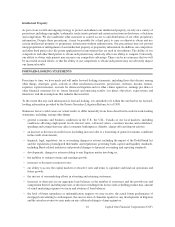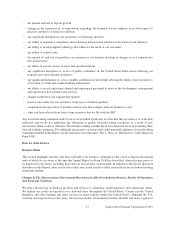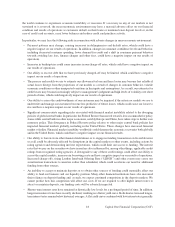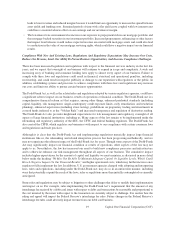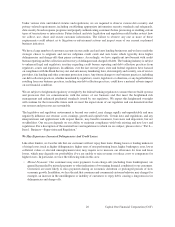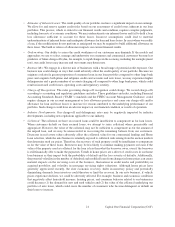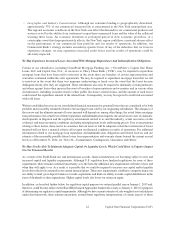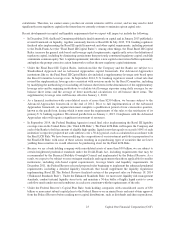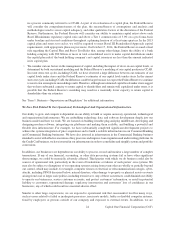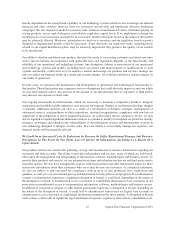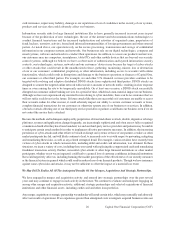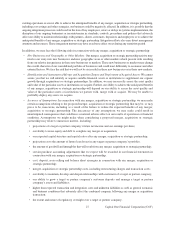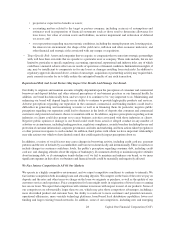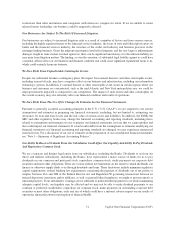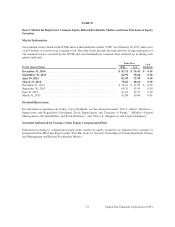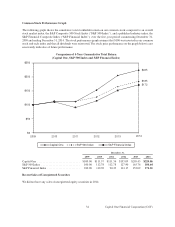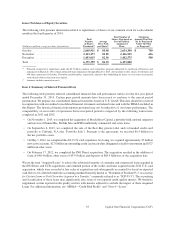Capital One 2014 Annual Report Download - page 47
Download and view the complete annual report
Please find page 47 of the 2014 Capital One annual report below. You can navigate through the pages in the report by either clicking on the pages listed below, or by using the keyword search tool below to find specific information within the annual report.heavily dependent on the strength and capability of our technology systems which we use to manage our internal
financial and other systems, interface with our customers and develop and implement effective marketing
campaigns. We also depend on models to measure risks, estimate certain financial values, determine pricing on
certain products, assess capital adequacy and calculate regulatory capital levels. If we implement or design our
models poorly or use inaccurate assumptions in our models, business decisions based on the output of the models
may be adversely affected. Moreover, information we disclose to investors and our regulators based on poorly
designed or implemented models could be inaccurate. Some decisions our regulators make, including those
related to our capital distribution plans, may be adversely impacted if they perceive the quality of our models
to be insufficient.
Our ability to develop and deliver new products that meet the needs of our existing customers and attract new ones
and to run our business in compliance with applicable laws and regulations depends on the functionality and
reliability of our operational and technology systems. Any disruptions, failures or inaccuracies of our operational
and technology systems and models, including those associated with improvements or modifications to such
systems and models, could cause us to be unable to market and manage our products and services, manage our
risk or to report our financial results in a timely and accurate manner, all of which could have a negative impact on
our results of operations.
In some cases, we outsource the maintenance and development of operational and technological functionality to
third parties. These third parties may experience errors or disruptions that could adversely impact us and over which
we may have limited control. Any increase in the amount of our infrastructure that we outsource to third parties
may increase our exposure to these risks.
Our ongoing investments in infrastructure, which are necessary to maintain a competitive business, integrate
acquisitions and establish scalable operations, may increase our expenses. Further, as our business develops, changes
or expands, additional expenses can arise as a result of a reevaluation of business strategies, management of
outsourced services, asset purchases or other acquisitions, structural reorganization, compliance with new laws or
regulations or the integration of newly acquired businesses. As cybersecurity threats continue to evolve, we may
also be required to expend significant additional resources to continue to modify or strengthen our protective security
measures, investigate and remediate any vulnerabilities of our information systems and infrastructure or invest in
new technology designed to mitigate security risks. If we are unable to successfully manage our expenses, our
financial results will be negatively affected.
We Could Incur Increased Costs Or Reductions In Revenue Or Suffer Reputational Damage And Business
Disruptions In The Event Of The Theft, Loss Or Misuse Of Information, Including As A Result Of A
Cyber-Attack.
Our products and services involve the gathering, storage and transmission of sensitive information regarding our
customers and their accounts. Our ability to provide such products and services, many of which are web-based,
relies upon the management and safeguarding of information, software, methodologies and business secrets. To
provide these products and services, we use information systems and infrastructure that we and third-party service
providers operate. We also have arrangements in place with retail partners and other third parties where we share
and receive information about their customers who are or may become our customers. As a financial institution,
we also are subject to and examined for compliance with an array of data protection laws, regulations and
guidance, as well as to our own internal privacy and information security policies and programs. If our information
systems or infrastructure experience a significant disruption or breach, it could lead, depending on the nature of
the disruption or breach, to unauthorized access to personal or confidential information of our customers in our
possession or unauthorized access to our proprietary information, software, methodologies and business secrets.
In addition, if our partners, retailers or other market participants experience a disruption or breach, depending on
the nature of the disruption or breach, it could lead to unauthorized transactions on Capital One accounts or
unauthorized access to personal or confidential information maintained by those entities. A disruption or breach
such as these could result in significant legal and financial exposure, regulatory intervention, remediation costs,
25 Capital One Financial Corporation (COF)



